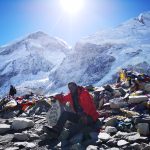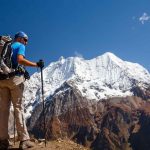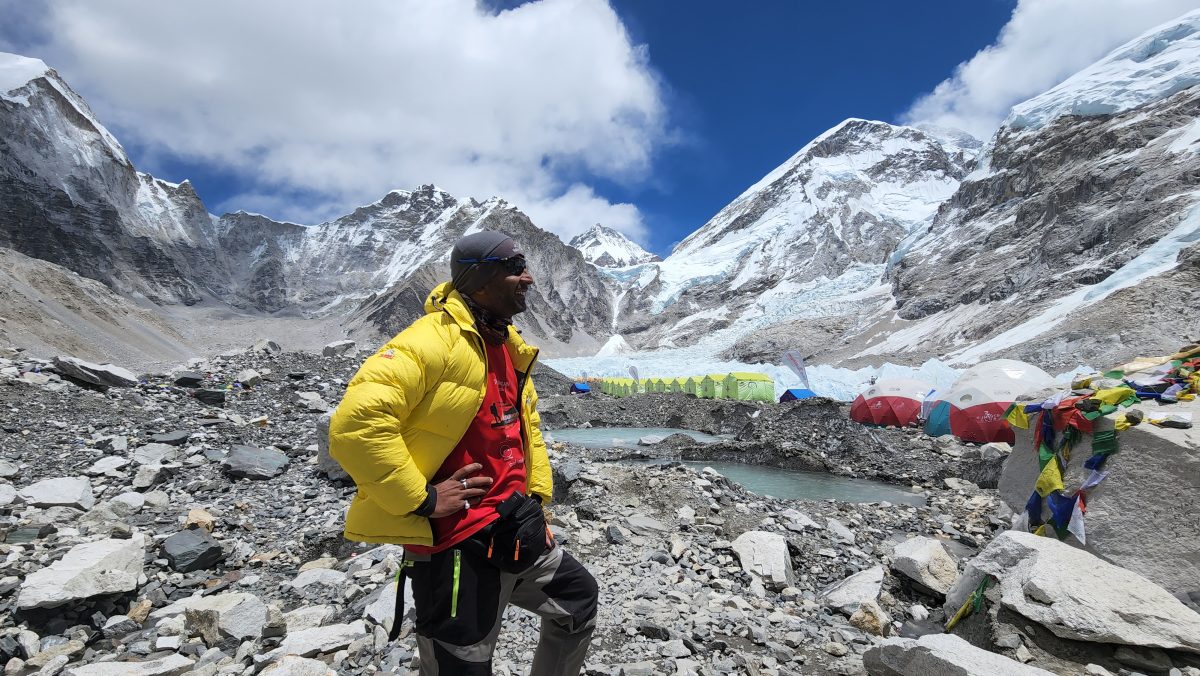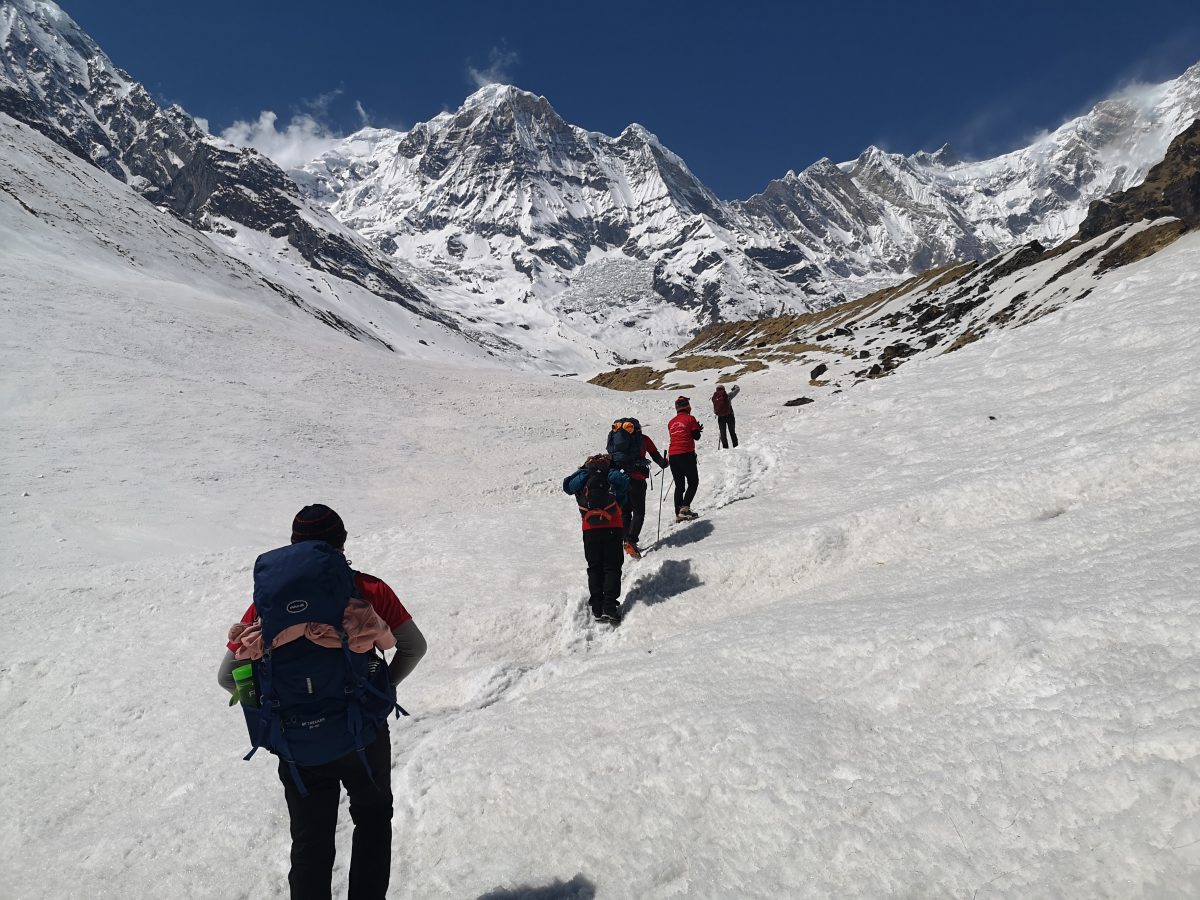
Everest Base Camp Trekking Cost
March 20, 2024
Manaslu Trekking: A Journey Into Nepal’s Untouched Himalayan Beauty
January 23, 2025
Everest Base Camp Trekking Cost
March 20, 2024
Manaslu Trekking: A Journey Into Nepal’s Untouched Himalayan Beauty
January 23, 2025Introduction
The Everest Base Camp Trek is an iconic adventure that attracts trekkers from all over the world. This challenging journey leads to the base of the world’s highest peak, Mount Everest, at 5,364 meters (17,598 feet). However, while the destination is awe-inspiring, the journey itself presents a variety of physical, mental, and environmental challenges. The path is not only demanding in terms of altitude, terrain, and weather but also requires mental strength and resilience.
1. Acute Mountain Sickness (AMS): Dealing with High Altitudes
What Is AMS?
As you ascend into higher altitudes, the body’s ability to absorb oxygen diminishes. This lack of oxygen can lead to Acute Mountain Sickness (AMS), a condition that is one of the primary risks for trekkers at altitudes above 2,500 meters (8,200 feet). The symptoms of AMS can be mild, such as headaches and nausea, or severe, resulting in life-threatening conditions such as High-Altitude Pulmonary Edema (HAPE) and High-Altitude Cerebral Edema (HACE).
AMS is one of the most common and dangerous challenges on the Everest Base Camp Trek, especially since the trek reaches an altitude where oxygen levels are only half of what they are at sea level.
How to Prevent and Manage AMS
- Gradual Acclimatization
The most effective way to prevent AMS is through acclimatization. It is essential to ascend slowly, allowing your body time to adjust to decreasing oxygen levels. Never increase your sleeping altitude by more than 500 meters (1,640 feet) per day. As a rule, for every 3 days of ascent, plan to take a rest day. These days allow the body to adjust, reducing the likelihood of AMS. - Hydration Keeping hydrated is vital when trekking at high altitudes. Dehydration can worsen the symptoms of AMS. Always carry water and drink regularly throughout the day. Avoid alcohol and caffeine as they contribute to dehydration.
- Recognize the Symptoms Early
Be aware of the early signs of AMS, such as headaches, nausea, dizziness, and loss of appetite. If you start experiencing symptoms, descend immediately to a lower altitude and rest. Delaying this can exacerbate the condition and increase the risk of developing more severe altitude-related illnesses like HAPE and HACE. - Use of Medication
Diamox (Acetazolamide) is commonly prescribed to help with acclimatization and reduce symptoms of AMS. It helps the body adjust more efficiently to the lower oxygen levels found at high altitudes. However, it’s important to consult a doctor before using Diamox to ensure it is safe for you.
2. Freezing Temperatures: Braving the Cold
The temperatures on the Everest Base Camp Trek can be extremely cold, particularly at night and in the early mornings. Even during the trekking season (pre-monsoon in spring and post-monsoon in autumn), temperatures at higher altitudes can drop well below freezing. The cold can affect your overall comfort and can also cause serious health problems if you are unprepared.
How to Stay Warm
- Layering Your Clothing
One of the most important strategies to stay warm is to wear layers of clothing. This allows you to adjust your clothing based on your activity level and the weather. Start with a moisture-wicking base layer to keep sweat away from your skin. Add an insulating mid-layer, such as fleece or down, to retain body heat. Finally, a waterproof and windproof outer layer is essential to protect you from the elements. - Insulated Sleeping Bag
At night, temperatures can plummet, and if you are not properly insulated, you risk frostbite or hypothermia. A good-quality sleeping bag rated for temperatures as low as -10°C (14°F) is necessary for higher altitudes. Also, consider using a sleeping pad, which helps to insulate your body from the cold ground. - Protect Your Extremities
Extremities like fingers, toes, and ears are particularly vulnerable to the cold. Insulated gloves, wool socks, and hats or earbuds are essential to prevent frostbite. Consider bringing an extra pair of gloves or socks in case the first pair gets wet. - Staying Warm During the Day
During the trek, staying active is key to staying warm. Moving at a steady pace generates body heat and helps you stay comfortable. If you stop for a break, try to limit the time spent idle, especially during the cold mornings or evenings.
3. Steep Ascents and Descents: Navigating Rugged Terrain
The Everest Base Camp Trek involves traversing rugged terrain, which includes steep ascents and descents. Some sections, especially between Namche Bazaar and Tengboche, are physically demanding, requiring trekkers to have good physical endurance and mental stamina. The rugged, rocky paths can be tough on the body, particularly when descending, as the constant pressure on your knees and joints can lead to discomfort and injury.
Managing Steep Terrain
- Pace Yourself
The key to handling steep ascents and descents is to pace yourself. Never rush through the difficult sections. It’s important to move steadily, taking regular breaks. Avoid pushing your body too hard, as this can lead to exhaustion or injury. - Trekking Poles
Trekking poles can significantly improve your stability on uneven terrain. They provide additional support, especially when descending, and can help reduce the impact on your knees. Trekking poles also help you maintain balance when walking on loose or slippery rocks. - Strengthening Exercises
Preparing physically for the trek by strengthening your legs can make steep climbs and descents more manageable. Exercises like squats, lunges, and calf raises will help build strength and endurance in your legs, which will help you on the trail. Also, focus on strengthening your core muscles, as a strong core provides greater balance and stability on the trail. - Good Footwear
Having sturdy, well-fitted hiking boots is essential. The terrain can be rocky and uneven, and the risk of twisting an ankle or slipping is high if your footwear is not up to the challenge. Ensure your boots have good ankle support and a strong grip, as they’ll help you navigate the rocky paths with more ease and safety.
4. Limited Oxygen: The Challenge of Thin Air
At altitudes above 3,000 meters (9,843 feet), the atmosphere contains significantly less oxygen. By the time you reach Everest Base Camp at 5,364 meters (17,598 feet), the oxygen level is only about half of what it is at sea level. This reduction in oxygen can make breathing more difficult and increase fatigue, especially during physical exertion.
Coping with Reduced Oxygen
- Ascend Slowly
To cope with the decreasing oxygen levels, it is crucial to ascend slowly. As your body acclimatizes to the altitude, it will produce more red blood cells to carry oxygen throughout your body. By limiting your rate of ascent and allowing rest days, you can minimize the risk of altitude sickness and give your body the time it needs to adjust. - Breathing Techniques
Breathing deeply and slowly can help you maintain a better oxygen supply. Inhale deeply through your nose and exhale slowly through your mouth. This helps maximize oxygen intake and avoid shortness of breath, which can be exacerbated by rapid or shallow breathing. - Proper Conditioning
Physical conditioning, particularly cardiovascular training, can help you better cope with lower oxygen levels. Aerobic exercises like running, cycling, and hiking will help improve your cardiovascular endurance and make it easier to breathe during the trek. A strong cardiovascular system is key to adapting more efficiently to high altitudes. - Rest and Listen to Your Body
If you feel dizzy, out of breath, or fatigued, take breaks and slow down. It is essential to listen to your body and rest when necessary to prevent overexertion. Do not push yourself beyond your limits, as this can lead to dangerous conditions such as AMS or exhaustion.
5. Mental and Emotional Fatigue: Staying Focused and Positive
The Everest Base Camp Trek is physically demanding, but it also requires significant mental endurance. Long, arduous days on the trail, coupled with physical discomfort, can lead to mental fatigue. Trekking at high altitudes, particularly when you start to feel the effects of AMS or the physical strain of the trek, can take a toll on your emotions and mindset.
Coping with Mental Fatigue
- Set Small Goals
Rather than focusing on the daunting task of reaching Everest Base Camp, break the trek into smaller, achievable goals. Reach one village, then another. Focus on completing each section rather than looking at the trek as a whole. This will help you stay motivated and reduce the overwhelming feeling of the long journey ahead. - Stay Positive
A positive mindset is one of the most important tools for overcoming the challenges of the trek. Whenever you feel mentally fatigued, remind yourself of the incredible views and experiences that await you. Keeping a positive attitude will help you power through tough moments and keep you focused on your goal. - Take Breaks
If you begin to feel mentally drained, take short breaks to rest and recharge. These breaks will help you reset and regain focus, allowing you to continue the trek with renewed energy. Don’t hesitate to take breaks when needed—mental fatigue is just as taxing as physical exhaustion. - Stay Connected
If you’re trekking with others, communicate and support each other. Sharing the experience with fellow trekkers can reduce feelings of isolation and boost morale, making it easier to continue despite the emotional and mental challenges of the trek.
Conclusion
The Everest Base Camp Trek presents numerous challenges, from the risk of AMS to the physical demands of navigating steep terrain and coping with the cold. However, with the right preparation, a careful approach to acclimatization, and the proper mental and physical conditioning, these challenges can be successfully managed. Understanding the risks and how to deal with them will not only make your journey more manageable but will also help you enjoy one of the most breathtaking and rewarding treks in the world.
By addressing each challenge thoughtfully, you will be equipped to handle the demanding aspects of the Everest Base Camp Trek and accomplish this incredible feat safely and with confidence.



